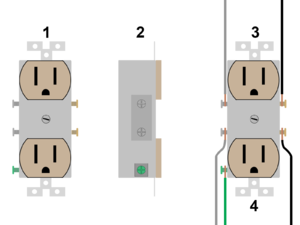Outlet
Jump to navigation
Jump to search
Outlets allow alternating current appliances to be safely connected and disconnected. Outlet design varies between countries, but the overall concept remains is the same for most residential circuits: there are either two pins (a circuit) or three pins (a circuit plus ground). As outlet designs vary between countries, the proper method for wiring and installing outlets will vary.
For examples of how to wire basic load circuits see - Wiring basic load circuits.
Considerations
- Outlets typically have multiple connection points for both wires of a circuit - this allows outlets to be easily connected in parallel.
- Outlets should always be installed in a junction box or other type of enclosure to ensure that all live metal parts are protected. If they are going to be installed outdoors, they must be installed in a suitable outdoor rated enclosure.
- If a system has an AC system ground then an equipment ground must be run to all outlets and the outlets should have three pins in order to provide a ground for user safety.
- Outlets should not be installed in locations where they will be exposed to water or else a residual current device must be installed to reduce the risk of electric shock.
- Connecting stranded wire to some types of outlets must be done very carefully to create a proper connection with no stray strands of wire.
- Ensure that all wires are properly attached to the outlet by tugging on them after tightening the screws on the outlet.
